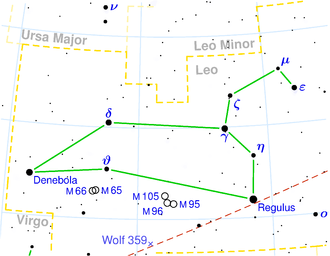NGC 3837
| Galaxy NGC 3837 |
|
|---|---|
![NGC 3837 with LEDA 1609155 (l) [1] SDSS mount](https://upload.wikimedia.org/wikipedia/commons/thumb/8/85/NGC3837_-_SDSS_DR14.jpg/300px-NGC3837_-_SDSS_DR14.jpg)
|
|
| NGC 3837 with LEDA 1609155 (l) SDSS image | |
| AladinLite | |
| Constellation | lion |
|
Position equinox : J2000.0 , epoch : J2000.0 |
|
| Right ascension | 11 h 43 m 56.426 s |
| declination | + 19 ° 53 ′ 40.48 ″ |
| Appearance | |
| Morphological type | E. |
| Brightness (visual) | 13.3 mag |
| Brightness (B-band) | 14.3 mag |
| Angular expansion | 0.8 ′ × 0.8 ′ |
| Surface brightness | 12.9 mag / arcmin² |
| Physical data | |
| Affiliation |
Abell 1367 WBL 353 |
| Redshift | 0.020447 ± 0.000033 |
| Radial velocity | 6130 ± 10 km / s |
|
Stroke distance v rad / H 0 |
(272 ± 19) · 10 6 ly (83.3 ± 5.8) Mpc |
| history | |
| discovery | William Herschel |
| Discovery date | April 26, 1785 |
| Catalog names | |
| NGC 3837 • UGC 6701 • PGC 36476 • CGCG 097-089 • MCG + 03-30-068 • 2MASX J11435642 + 1953403 • GC 2526 • H III 377 • h 961 • GALEX ASC J114356.43 + 195340.0 • LDCE 836 NED018 • WISEA J114356.41 + 195340.3 | |
NGC 3837 is an elliptical galaxy from the Hubble type E0 in Leo on the ecliptic . It is an estimated 272 million light years from the Milky Way and about 65,000 light years in diameter. Presumably it forms a gravitationally bound galaxy pair together with PGC 1609155 . She is considered a member of the Leo galaxy cluster Abell 1367 .
In the same area of the sky are u. a. the galaxies NGC 3841 , NGC 3842 , NGC 3845 , NGC 3851 .
The object was discovered by William Herschel on April 26, 1785 .
